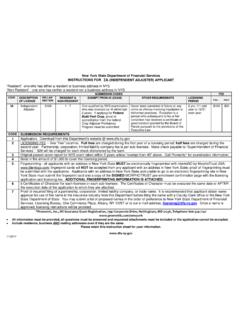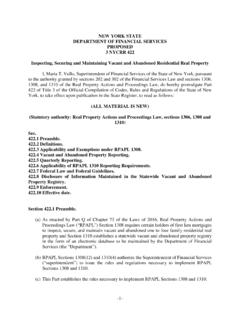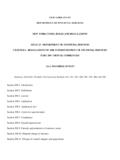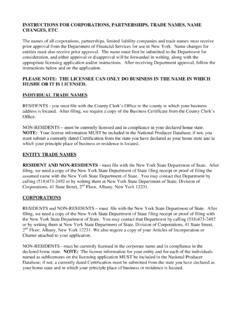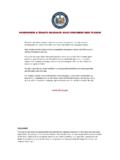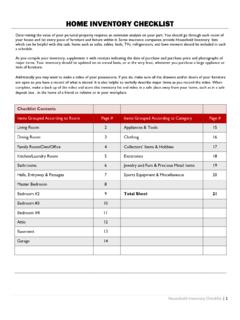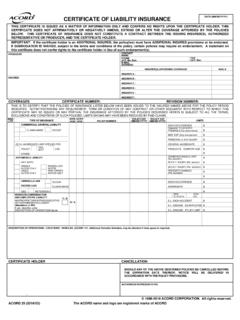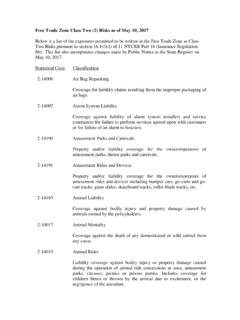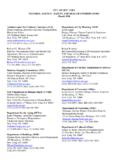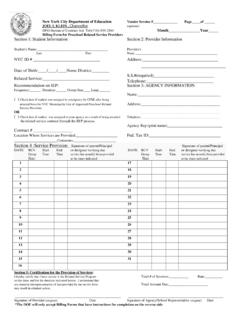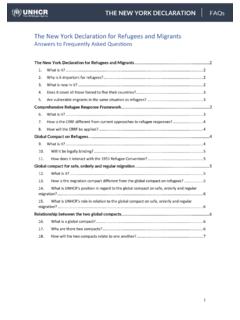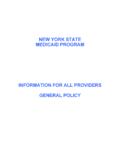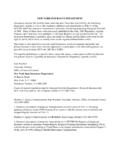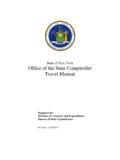Transcription of Adoption of New 23 NYCRR 500 of the Regulations …
1 NEW york STATE. department OF financial services . 23 NYCRR 500. cybersecurity REQUIREMENTS FOR financial services COMPANIES. I, Maria T. Vullo, Superintendent of financial services , pursuant to the authority granted by sections 102, 201, 202, 301, 302 and 408 of the financial services Law, do hereby promulgate Part 500 of Title 23 of the Official Compilation of Codes, Rules and Regulations of the State of New york , to take effect March 1, 2017, to read as follows: (ALL MATTER IS NEW). Section Introduction. The New york State department of financial services ( DFS ) has been closely monitoring the ever- growing threat posed to information and financial systems by nation- states , terrorist organizations and independent criminal actors. Recently, cybercriminals have sought to exploit technological vulnerabilities to gain access to sensitive electronic data. Cybercriminals can cause significant financial losses for DFS regulated entities as well as for New york consumers whose private information may be revealed and/or stolen for illicit purposes.
2 The financial services industry is a significant target of cybersecurity threats. DFS appreciates that many firms have proactively increased their cybersecurity programs with great success. Given the seriousness of the issue and the risk to all regulated entities, certain regulatory minimum standards are warranted, while not being overly prescriptive so that cybersecurity programs can match the relevant risks and keep pace with technological advances. Accordingly, this regulation is designed to promote the protection of customer information as well as the information technology systems of regulated entities. This regulation requires each company to assess its specific risk profile and design a program that addresses its risks in a robust fashion. Senior management must take this issue seriously and be responsible for the organization's cybersecurity program and file an annual certification confirming compliance with these Regulations .
3 A regulated entity's cybersecurity program must ensure the safety and soundness of the institution and protect its customers. It is critical for all regulated institutions that have not yet done so to move swiftly and urgently to adopt a cybersecurity program and for all regulated entities to be subject to minimum standards with respect to their programs. The number of cyber events has been steadily increasing and estimates of potential risk to our financial services industry are stark. Adoption of the program outlined in these Regulations is a priority for New york State. Section Definitions. For purposes of this Part only, the following definitions shall apply: (a) Affiliate means any Person that controls, is controlled by or is under common control with another Person. For purposes of this subsection, control means the possession, direct or indirect, of the power to direct or cause the direction of the management and policies of a Person, whether through the ownership of stock of such Person or otherwise.
4 1. (b) Authorized User means any employee, contractor, agent or other Person that participates in the business operations of a Covered Entity and is authorized to access and use any Information Systems and data of the Covered Entity. (c) Covered Entity means any Person operating under or required to operate under a license, registration, charter, certificate, permit, accreditation or similar authorization under the Banking Law, the Insurance Law or the financial services Law. (d) cybersecurity Event means any act or attempt, successful or unsuccessful, to gain unauthorized access to, disrupt or misuse an Information System or information stored on such Information System. (e) Information System means a discrete set of electronic information resources organized for the collection, processing, maintenance, use, sharing, dissemination or disposition of electronic information, as well as any specialized system such as industrial/process controls systems, telephone switching and private branch exchange systems, and environmental control systems.
5 (f) Multi-Factor Authentication means authentication through verification of at least two of the following types of authentication factors: (1) Knowledge factors, such as a password; or (2) Possession factors, such as a token or text message on a mobile phone; or (3) Inherence factors, such as a biometric characteristic. (g) Nonpublic Information shall mean all electronic information that is not Publicly Available Information and is: (1) Business related information of a Covered Entity the tampering with which, or unauthorized disclosure, access or use of which, would cause a material adverse impact to the business, operations or security of the Covered Entity;. (2) Any information concerning an individual which because of name, number, personal mark, or other identifier can be used to identify such individual, in combination with any one or more of the following data elements: (i) social security number, (ii) drivers' license number or non-driver identification card number, (iii).
6 Account number, credit or debit card number, (iv) any security code, access code or password that would permit access to an individual's financial account, or (v) biometric records;. (3) Any information or data, except age or gender, in any form or medium created by or derived from a health care provider or an individual and that relates to (i) the past, present or future physical, mental or behavioral health or condition of any individual or a member of the individual's family, (ii) the provision of health care to any individual, or (iii) payment for the provision of health care to any individual. 2. (h) Penetration Testing means a test methodology in which assessors attempt to circumvent or defeat the security features of an Information System by attempting penetration of databases or controls from outside or inside the Covered Entity's Information Systems. (i) Person means any individual or any non-governmental entity, including but not limited to any non- governmental partnership, corporation, branch, agency or association.
7 (j) Publicly Available Information means any information that a Covered Entity has a reasonable basis to believe is lawfully made available to the general public from: federal, state or local government records; widely distributed media; or disclosures to the general public that are required to be made by federal, state or local law. (1) For the purposes of this subsection, a Covered Entity has a reasonable basis to believe that information is lawfully made available to the general public if the Covered Entity has taken steps to determine: (i) That the information is of the type that is available to the general public; and (ii) Whether an individual can direct that the information not be made available to the general public and, if so, that such individual has not done so. (k) Risk Assessment means the risk assessment that each Covered Entity is required to conduct under section of this Part. (l) Risk-Based Authentication means any risk-based system of authentication that detects anomalies or changes in the normal use patterns of a Person and requires additional verification of the Person's identity when such deviations or changes are detected, such as through the use of challenge questions.
8 (m) Senior Officer(s) means the senior individual or individuals (acting collectively or as a committee). responsible for the management, operations, security, information systems, compliance and/or risk of a Covered Entity, including a branch or agency of a foreign banking organization subject to this Part. (n) Third Party Service Provider(s) means a Person that (i) is not an Affiliate of the Covered Entity, (ii). provides services to the Covered Entity, and (iii) maintains, processes or otherwise is permitted access to Nonpublic Information through its provision of services to the Covered Entity. Section cybersecurity Program. (a) cybersecurity Program. Each Covered Entity shall maintain a cybersecurity program designed to protect the confidentiality, integrity and availability of the Covered Entity's Information Systems. (b) The cybersecurity program shall be based on the Covered Entity's Risk Assessment and designed to perform the following core cybersecurity functions: (1) identify and assess internal and external cybersecurity risks that may threaten the security or integrity of Nonpublic Information stored on the Covered Entity's Information Systems.
9 3. (2) use defensive infrastructure and the implementation of policies and procedures to protect the Covered Entity's Information Systems, and the Nonpublic Information stored on those Information Systems, from unauthorized access, use or other malicious acts;. (3) detect cybersecurity Events;. (4) respond to identified or detected cybersecurity Events to mitigate any negative effects;. (5) recover from cybersecurity Events and restore normal operations and services ; and (6) fulfill applicable regulatory reporting obligations. (c) A Covered Entity may meet the requirement(s) of this Part by adopting the relevant and applicable provisions of a cybersecurity program maintained by an Affiliate, provided that such provisions satisfy the requirements of this Part, as applicable to the Covered Entity. (d) All documentation and information relevant to the Covered Entity's cybersecurity program shall be made available to the superintendent upon request.
10 Section cybersecurity Policy. cybersecurity Policy. Each Covered Entity shall implement and maintain a written policy or policies, approved by a Senior Officer or the Covered Entity's board of directors (or an appropriate committee thereof) or equivalent governing body, setting forth the Covered Entity's policies and procedures for the protection of its Information Systems and Nonpublic Information stored on those Information Systems. The cybersecurity policy shall be based on the Covered Entity's Risk Assessment and address the following areas to the extent applicable to the Covered Entity's operations: (a) information security;. (b) data governance and classification;. (c) asset inventory and device management;. (d) access controls and identity management;. (e) business continuity and disaster recovery planning and resources;. (f) systems operations and availability concerns;. (g) systems and network security;. (h) systems and network monitoring.
